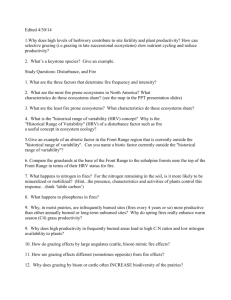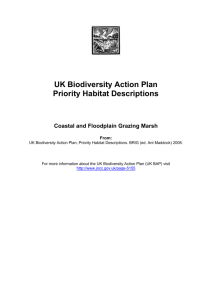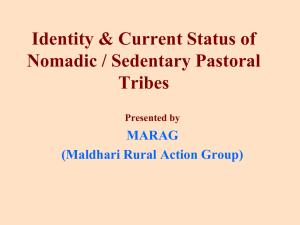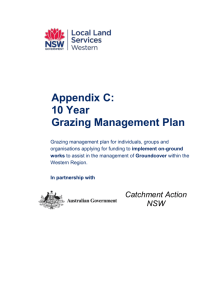Molloy_Brian - High Country Accord
advertisement
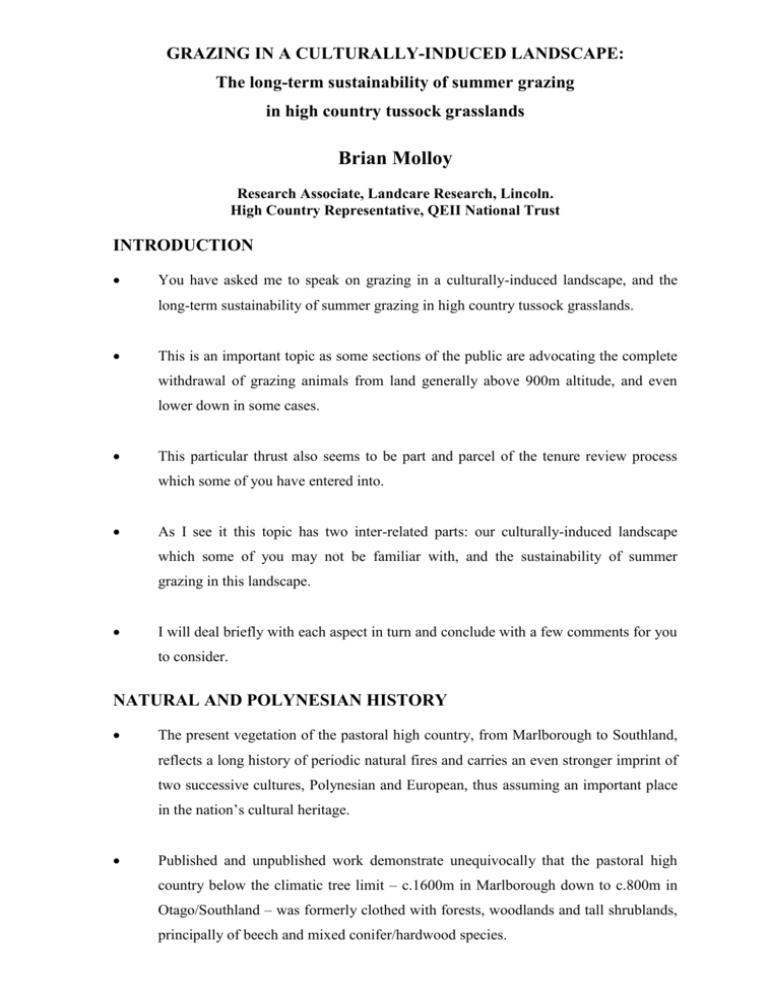
GRAZING IN A CULTURALLY-INDUCED LANDSCAPE: The long-term sustainability of summer grazing in high country tussock grasslands Brian Molloy Research Associate, Landcare Research, Lincoln. High Country Representative, QEII National Trust INTRODUCTION You have asked me to speak on grazing in a culturally-induced landscape, and the long-term sustainability of summer grazing in high country tussock grasslands. This is an important topic as some sections of the public are advocating the complete withdrawal of grazing animals from land generally above 900m altitude, and even lower down in some cases. This particular thrust also seems to be part and parcel of the tenure review process which some of you have entered into. As I see it this topic has two inter-related parts: our culturally-induced landscape which some of you may not be familiar with, and the sustainability of summer grazing in this landscape. I will deal briefly with each aspect in turn and conclude with a few comments for you to consider. NATURAL AND POLYNESIAN HISTORY The present vegetation of the pastoral high country, from Marlborough to Southland, reflects a long history of periodic natural fires and carries an even stronger imprint of two successive cultures, Polynesian and European, thus assuming an important place in the nation’s cultural heritage. Published and unpublished work demonstrate unequivocally that the pastoral high country below the climatic tree limit – c.1600m in Marlborough down to c.800m in Otago/Southland – was formerly clothed with forests, woodlands and tall shrublands, principally of beech and mixed conifer/hardwood species. Shrubs, tussocks and other herbs below the climatic tree limit occupied rock outcrops, alluvial surfaces and other sites hostile to tree growth during the forest era, or as successions back to forest on disturbed sites. Above the climatic tree limit, subalpine and alpine shrubs, tussocks, and other herbs of a rich and varied composition prevailed during the forest era, in places sharing this uppermost altitudinal belt with extensive areas of natural stone pavements, screes and rock outcrops. The former forests, woodlands and tall shrublands were depleted first by local natural fires, probably ignited by lightening, which occurred over the last 10,000 years at approximately 500 to 1,000 year intervals up to about 1,000 years ago. However, the major period of deforestation took place during Polynesian times, which began about 1,000 years ago and continued up to the arrival of European settlers about 150 years ago. The evidence of forest clearance in the pastoral high country by natural and Polynesian fires is widespread and compelling, and consists of buried charcoals in soils; surface and buried wood, often fire-scarred; fossil pollen and fine charcoal in surface peats; and soil profile characteristics. The age of some of this material has been pinpointed by radiocarbon dating, and the species involved have been determined by the identification of charcoal, wood and pollen types. This evidence is still accumulating and being documented. POST-FIRE TRENDS Following the different episodes of natural fires, some lands were re-occupied by woody vegetation only to be burnt again. Other lands were colonised by tall tussock species and associated herbs, bracken fern, manuka, kanuka, and members of the socalled “grey scrub” communities migrating downhill and across slopes from various non-forested refugia. 2 The initial and repeated fires of the Polynesian era continued these trends and promoted the further expansion and consolidation of fire-tolerant tussocks and other native herbs at the expense of less-tolerant woody elements. Not all the woody vegetation was consumed by these fires, and pockets of forest and scrub of various kinds have persisted on bouldery or rocky sites and in deep gullies where the spread of fire was minimised. Buried shrub and grass charcoals in soils above the climatic tree limit indicate that subalpine and alpine vegetation was not immune from natural or Polynesian fires, and there is evidence to suggest that present tree limits in some regions are depressed as a result of these earlier fires. Thus, the pre-eminence of tall-tussock grassland below tree limit prior to European settlement was clearly a product of natural and cultural fires, aided by the ability of tall-tussocks and other species to exploit a wide range of sites vacated by woody plants, including stable, truncated and composite soils of varied fertility, and also to withstand further burning. At the time of European settlement most of our tussock grassland and shrubland plants, including many currently regarded as threatened, were more abundant than they would have been during the forest era, or indeed at any time in the history of the high country. The fossil pollen record bears this out. Likewise, the diversity of species in these induced and dynamic plant communities most probably reached unprecedented levels. THE PASTORAL ERA The introduction of domestic grazing animals, feral animals such as rabbits, hares and ungulates, exotic plants, and the frequent burning that accompanied the early pastoral era set in train a further sequence of changes in native secondary plant communities which continues to a greater or lesser extent at the present time. The areas most affected were hill slopes and valley floors below about 1,000m. The most obvious change was a visual one in which the once common tall tussocks 3 gradually lost their structural dominance, at first to short tussocks, and ultimately to sward-forming exotic grasses and other herbs. Native grasses, with their loosely tufted, somewhat top heavy growth habit, proved ill-adapted to grazing, weakly competitive with exotic species, and generally incapable of forming grazing-resistant swards. Above c.1,000m tall tussock grassland has proved to be more resistant to fire and sheep grazing and tall tussocks have retained their structural dominance. There is no evidence of loss of native companion species from these grasslands, but there has been a reduction in their frequency following the invasion of exotic grasses and other herbs leading to new, dynamic plant communities with a diverse intertussock flora of mixed origins. Likewise, I am not aware of any native plant having gone extinct in the pastoral high country as a result of fire or grazing within the last 150 years. On the lower driest country, formerly covered with sparse native grasses and other herbs, depletion reached an advanced state, caused principally by episodes of rabbits in excess, and epitomised by large expanses of native scabweeds and bare ground. The elimination of only rabbits from such lands has resulted in rapid re-vegetation by exotic and native plants and the virtual elimination of scabweeds. Generally, the vegetation in the subalpine and alpine zones above tree limit has been less affected by burning and grazing, although some areas have clearly been more affected by grazing and foot traffic than others. During the pastoral era there has been little attrition of forest and tall scrub remnants since the first records were taken by the early surveyors. Some of these remnants show signs of active regeneration and expansion, others, somewhat depauperate, will require management input to survive and expand. One of the most spectacular trends in the pastoral era is the relatively rapid expansion of grey scrub throughout the high country. In part this is a response to a wide range 4 of inherently fertile sites, and in part a response to aerial topdressing over the last 5060 years. Matagouri and native brooms, both nitrogen fixers, are examples that spring to mind. Both have responded in spectacular fashion to the application of fertiliser. Another notable trend is the expanding frontier of aggressive and highly competitive exotic plants which have exposed deficiencies in the competitive ability of native plants, whether in disturbed or undisturbed vegetation, and especially, although not exclusively, below the climatic tree limit. Put simply, there are no native equivalents of willows, lupins, gorse and broom in our stream beds and adjoining terraces; gorse, broom, sweet brier, hawthorn, thyme and wilding pines on our hillsides; and the widespread hawkweeds, sorrel, haresfoot trefoil and a raft of exotic grasses. The exotic grasses and hawkweeds in particular have shown a remarkable rise to prominence in recent years, and pose a continuing threat to pastoral values and the conservation or restoration of native biodiversity, especially with the complete withdrawal of grazing animals. CONCLUDING COMMENTS In the 55 years I have been associated with the high country I have been greatly impressed with the resilience of native plants in the face of periodic burning and grazing. In my opinion, this says a lot for a flora which many claim has evolved in the absence of grazing and browsing animals, and therefore under constant threat. Is the continued grazing of tussock grasslands in the mid to high altitudes, the traditional summer country, sustainable? My answer is a qualified yes. While I have complete confidence in the plants, I am somewhat apprehensive about how we manage them. I believe we can do much better than we have in the past to reduce or eliminate the tension points and hot spots that have arisen with excessive grazing. This may involve a re-think of the number 5 and class of livestock used, and the frequency and duration of grazing; the judicious use of fertiliser and, where applicable, seed; and meaningful monitoring. We must also remember that our traditional summer country supports an array of plant communities, both primary and secondary, and their associated fauna, with high conservation values and therefore worthy of serious consideration in the future management of this country. Of one thing I am certain, some grazing will be better than no grazing, if we are to retain both the pastoral and conservation values of this country. In my view, the tussock landscapes which people applaud, and the quest for tussock grassland parks, are a tribute to your stewardship of the high country, a stewardship I believe you should be allowed to continue, but with greater attention to a wider range of inherent values and their appropriate management. 6
